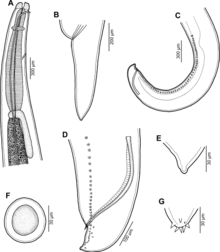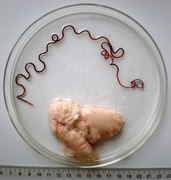Blacktip grouper
| Blacktip grouper | |
|---|---|

| |
| Adult of Epinephelus fasciatus | |
| Scientific classification | |
| Domain: | Eukaryota |
| Kingdom: | Animalia |
| Phylum: | Chordata |
| Class: | Actinopterygii |
| Order: | Perciformes |
| Family: | Serranidae |
| Subfamily: | Epinephelinae |
| Tribe: | Epinephelini |
| Genus: | Epinephelus |
| Species: | E. fasciatus
|
| Binomial name | |
| Epinephelus fasciatus Forsskål, 1775
| |
| Synonyms[2] | |
| |
The blacktip grouper (Epinephelus fasciatus), also known as the redbanded grouper, blacktipped cod, black-tipped rockcod, footballer cod, red-barred cod, red-barred rockcod, scarlet rock-cod or weathered rock-cod, is a species of marine
Epinephelinae which is part of the family Serranidae, which also includes the anthias and sea basses. It is found in the tropical Indo-Pacific region. It is the type species of the genus Epinephelus
.
Description
The blacktip grouper has a body which has a
caudal fin is moderately rounded. There are 49-75 scales in the lateral line.[3] The colour is variable and ranges from pale greenish grey to pale reddish yellow to scarlet. They frequently have 5 or 6 faint dark bars, the final one being on the caudal peduncle. The scales on the upper body have a pale centre and dark rear margin, which creates am indistinct checked pattern. The outer membrane of the spiny part of the dorsal fin is black, or dark red in specimens from Western Australia and some from deep water. There is a pale yellow or white spot to the rear of the tip of each of the dorsal fin spines. This species attains a maximum total length of 40 centimetres (16 in), although a more common length is around 22 centimetres (8.7 in), and a weight of 2.0 kilograms (4.4 lb).[2]
Distribution
The blacktip grouper has a wide Indo-Pacific distribution. Its range extends from the
Mascarenes, Comoros and the Seychelles in the Indian Ocean as well.[1] In Australia it occurs from the Houtman Abrolhos in Western Australia north around the tropical coastline and then as far south as Port Hacking in New South Wales. It can also be found on reefs in the Coral Sea, Elizabeth Reef, around Lord Howe Island in the Tasman Sea and Christmas Island.[4] A single record was reported in 2012 from the eastern Mediterranean Sea, off Lebanon.[5]
Biology
This species may present simultaneous hermaphroditism in smaller individuals, while the large individuals usually lose female function.[2]
The blacktip grouper feeds on
brackish water, sometimes in groups of 10-15 individuals.[2][6] Juveniles may find shelter in mangrove swamps.[7]
Blacktip groupers of the
ciguatera poisoning.[2]
Parasites

Blacktip groupers are host of several
parasites, including Pseudorhabdosynochus spp. (diplectanid Monogeneans) on the gills.[8] The philometrid nematode Philometra fasciati is parasitic in the ovary of female fish;[9]
the adult female parasite is a red worm which can reach up to 40 centimetres in length, for a diameter of only 1.6 millimetre; the males are tiny.
Raphidascaris (Ichthyascaris) fasciati is a nematode parasitic in the intestine, 20 mm in length, described in 2020 and named after the fish.[10]
Taxonomy
The blacktip grouper was first formally
naturalist Marcus Elieser Bloch (1723–1799) created the new genus Epinephelus when he described E. marginalis in 1793, however E. marginalis is a synonym of Perca fasciata[12] and this means that this species is the type species of its genus.[13]
Gallery
-
Juvenile
-
Adult
-
A variant of an adult with a pale body and a red front part
-
Nematoda, Philometridae), a parasite of the ovary of the blacktip grouper
References
- ^ . Retrieved 19 November 2021.
- ^ a b c d e f g Froese, Rainer; Pauly, Daniel (eds.) (2019). "Epinephelus fasciatus" in FishBase. December 2019 version.
- ^ ISBN 92-5-103125-8.
- ^ Bray, D.J. (2018). "Epinephelus fasciatus". Fishes of Australia. Museums Victoria. Retrieved 4 July 2020.
- ^ Atlas of Exotic Fishes in the Mediterranean Sea (Epinephelus fasciatus). 2nd Edition. 2021. 366p. CIESM Publishers, Paris, Monaco.https://ciesm.org/atlas/fishes_2nd_edition/Epinephelus_fasciatus.pdf
- ^ ISBN 0-00-715986-2.
- ^ ISBN 88-87177-42-2.
- S2CID 35119181.
- PMID 24836940.

- PMID 32223885.

- ^ Eschmeyer, William N.; Fricke, Ron & van der Laan, Richard (eds.). "Perca fasciata". Catalog of Fishes. California Academy of Sciences. Retrieved 11 July 2020.
- ^ Eschmeyer, William N.; Fricke, Ron & van der Laan, Richard (eds.). Epinephelus "Species in the genus 'Epinephelus'". Catalog of Fishes. California Academy of Sciences. Retrieved 11 July 2020.
- ^ Eschmeyer, William N.; Fricke, Ron & van der Laan, Richard (eds.). "Epinephelus". Catalog of Fishes. California Academy of Sciences. Retrieved 11 July 2020.
External links
- Wildscreen Archive
- Photos of Blacktip grouper on Sealife Collection
Wikimedia Commons has media related to Epinephelus fasciatus.





